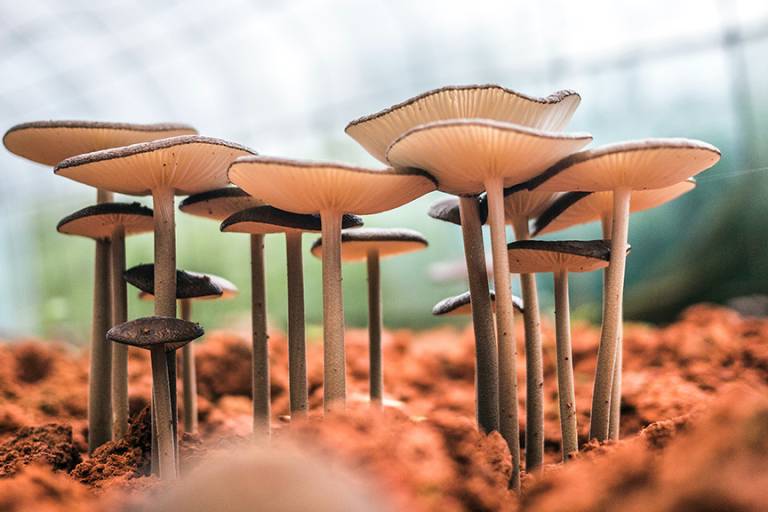5 Fantastic Facts about Fungi & Fibre That Will WOW Your Clients!
Blog by Specialist Dietitian and Clinical Lead, Catherine Rabess (BSc Hons RD)

1. 70% of the body’s entire immune system lives in the gut
The trillions of gut microbes that make up our gut microbiota, educate and support the development of the immune system throughout our lives starting at birth.
Without fibre, these gut microbes cannot survive to do the above and many other functions, which include:
- vitamin production
- maintenance of intestinal cells
- neutralisation of pathogens, drugs and toxins
The digestion of fibre creates short chain fatty acids (SCFAs) which provide a source of fuel for our gut cells. SCFAs also keep our gut lining healthy and reduce risk of the intestinal cell wall (gut barrier) becoming permeable and opening.
So, having a diet high in fibre improves gut barrier function, reducing the penetration of microbes into the blood circulatory system1, thereby reducing the immune responses that are associated with metabolic diseases2.
2. Looking to optimise gut health? Think fibre!
Fibre is an essential nutrient for our gut microbes and helps the gut microbiota to thrive as a form of complex ecosystem. Fibre also increases the bulk and softness of your stool and increases gut transit time, and binds to other compounds, which can help regulate blood sugars and lower cholesterol.
So, if you are not having enough it can result in:
- constipation
- decreased diversity of beneficial gut bacteria
- increased risk of developing non-communicable diseases
Studies have shown diets rich in fibre (25 – 29g) experience a 15 – 30% decrease in cardiovascular-related mortality, CHD, stroke, T2DM and colorectal cancer in comparison to those having low fibre diet3 .
3. Fungi are responsible for many valuable drugs, including antibiotics.
Since the accidental discovery of penicillin in 1928 by Sir Alexander Fleming, fantastic fungi have gone on to be a key, albeit humble, derivative for some of the most prescribed medications in the UK. Examples include contraception and cholesterol-lowering statins. Fungi are even used to produce the immunosuppressant ciclosporin, which helped to revolutionise the success of organ transplants by preventing rejection of the transplant5! Is there anything fungi can’t do?!
4. There’s a lot more to fibre than we think… (spoiler: it can get quite complicated!)
Let’s go back to basics for a minute - you’ll often hear fibre referenced as soluble and insoluble, but this determines its dissolvable capability and does not tell us much about the effect it has on the body.
Having a diverse variety of plant-based foods that are high in fibre has proven to have the most positive effects to our gut, by increasing the abundance of SCFA4 . Dietary fibres are classified as either polysaccharides (non-starch polysaccharides (NSP) and resistant starches) or oligosaccharides including fructo-oligosaccharides (FOS) and galacto-oligosaccharides (GOS) found in onions, garlic, chicory, beans and pulses.
NSP can be further classified as cellulose which is found in wholegrains, vegetables, fruits, seeds, nuts, bran etc.
Others include chitin found in Quorn mycoprotein, hemicellulose, lignans (polyphenols), beta-glucans (found in oats/barley/Quorn), pectins, gums and mucilages (used in gelling agents, thickeners, stabilisers and emulsifying agents), as well as resistant starches found in cooled potatoes, bananas, pulses, seeds etc.
So yeah – it’s a lot!
5. There’s a whole world of fantastic fungi out there that we are yet to explore!
In fact, only 148,000 species of fungi have been named to date, of an estimated 2.2–3.8 million6 . Crazy right?! This tells us that there is still little known about the power of fungi compared to what’s known about the animal and plant kingdoms…
But what we do know lots about is Quorn mycoprotein, fermented from a naturally occurring fungus called Fusarium venenatum! Research into Quorn’s unique mycoprotein goes back over 3 decades and depending on your interests, feel free to explore more about Quorn mycoprotein research and heart health, diabetes, or healthy ageing.
Another fungi species you may just recognise more than you think is Agaricus bisporus, which is commonly found in our supermarket aisle or local market. Specifically, portobello, button, white and chestnut – ring any bells? We often assume these are different types of mushrooms (especially when you see the difference in price!). But did you know, they’re all the same just at different stages of maturity, with no significant difference in nutritional composition.
Bottom line: Fungi is fab! Whether it’s providing us with a nutritious and sustainable meat-alternative like Quorn’s unique mycoprotein, or it’s helping us reach our 5 a day with a delicious chestnut mushroom risotto, let’s give fungi the recognition it deserves!

Blog by Specialist Dietitian and Clinical Lead, Catherine Rabess (BSc Hons RD)

References
1 Maslowski, K.M., Mackay, C.R. (2011) Diet, gut microbiota and immune responses. Nat Immunol. 2011;12(1):5 -9. DOI: https://doi.org/10.1038/ni0111-5
2 Knudsen K.E., et al. (2018) Impact of Diet-Modulated Butyrate Production on Intestinal Barrier Function and Inflammation. Nutrients. 2018;10:1499. DOI: https://doi.org/10.3390/nu10101499 .
3 Mayor S. (2019) Eating more fibre linked to reduced risk of non-communicable diseases and death, review finds. BMJ 2019; 364: l159. Published 10 January 2019 DOI: https://doi.org/10.1136/bmj.l159
4 Myhrstad MCW, Tunsjø H, Charnock C, Telle-Hansen VH. (2020) Dietary Fibre, Gut Microbiota, and Metabolic Regulation-Current Status in Human Randomized Trials. Nutrients. 2020;12(3):859. Published 23rd March 2020. https://doi.org/10.3390/nu12030859
5 Howes et al. (2020) Molecules from nature: Reconciling biodiversity conservation and global healthcare imperatives for sustainable use of medicinal plants and fungi. Plants, People, Planet 2(5). DOI: https://doi.org/10.1002/ppp3.10138
6 Grace et al. (2020). Plant Power: Opportunities and challenges for meeting sustainable energy needs from the plant and fungal kingdoms. Plants, People, Planet 2(5). DOI: https://doi.org/10.1002/ppp3.10147